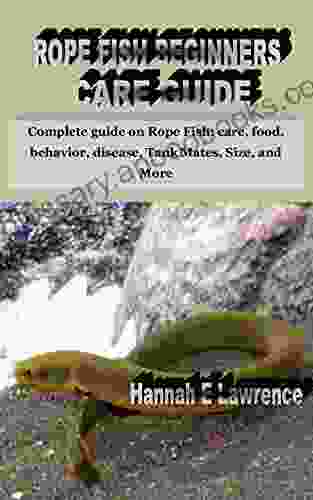Care, Food, Behavior, Disease, Tank Mates, Size, and More: The Ultimate Guide to Owning a Healthy and Happy Betta Fish

Betta fish, also known as Siamese fighting fish, are popular aquarium fish known for their vibrant colors and flowing fins. While they are relatively easy to care for, there are some essential factors to consider to ensure your betta fish lives a long and healthy life. This comprehensive article will provide detailed information on betta fish care, covering topics such as food, behavior, disease, tank mates, size, and more. Whether you're a seasoned aquarist or a beginner, this guide will help you create the best possible environment for your betta fish to thrive.
4.4 out of 5
| Language | : | English |
| File size | : | 1112 KB |
| Text-to-Speech | : | Enabled |
| Screen Reader | : | Supported |
| Enhanced typesetting | : | Enabled |
| Print length | : | 11 pages |
| Lending | : | Enabled |
Feeding Your Betta Fish
Nutritional Requirements
Betta fish are carnivores and require a diet rich in protein. Their natural diet consists mainly of insects, worms, and small crustaceans. In captivity, betta fish can be fed a variety of foods, including live, frozen, and dried options.
Live Food
Live food, such as brine shrimp, bloodworms, and fruit flies, is an excellent source of protein and essential nutrients for betta fish. However, it's important to rinse live food thoroughly before feeding it to your fish to prevent the of parasites or diseases.
Frozen Food
Frozen food, such as mysis shrimp and frozen bloodworms, is a convenient and nutritious alternative to live food. It's important to thaw frozen food before feeding it to your fish to avoid causing digestive problems.
Dried Food
Dried food, such as betta pellets and flakes, is a staple of many betta fish diets. It provides essential nutrients but should be fed in moderation as it can be more difficult for your fish to digest.
Feeding Schedule
Adult betta fish should be fed once or twice a day, depending on their appetite. Young betta fish may need to be fed more frequently. It's best to feed your betta fish small portions to prevent overeating and obesity.
Understanding Betta Fish Behavior
Aggression
Betta fish are known for their aggressive nature, especially towards other betta fish. This is why it's generally not recommended to keep multiple betta fish in the same tank. However, there are some exceptions, such as sorority tanks, where groups of female betta fish can live together peacefully.
Flaring
When betta fish are threatened or excited, they will often flare their gills and fins. This is a defensive behavior that makes them appear larger and more intimidating. Flaring is also a way for betta fish to communicate with each other.
Bubble Nesting
Male betta fish build bubble nests as part of their courtship ritual. They will blow bubbles and use them to create a nest where the female can lay her eggs. Bubble nesting is a natural behavior that can be observed in healthy betta fish.
Common Betta Fish Diseases
Fin Rot
Fin rot is a bacterial infection that affects the fins of betta fish. It can cause the fins to become torn, ragged, and discolored. Fin rot is often caused by poor water quality or stress.
Ich
Ich is a parasitic infection that causes white spots to appear on the body and fins of betta fish. It is highly contagious and can quickly spread to other fish in the tank. Ich is caused by a protozoan parasite called Ichthyophthirius multifiliis.
Dropsy
Dropsy is a condition that causes betta fish to swell up with fluid. It can be caused by a variety of factors, including bacterial infections, kidney disease, and liver disease. Dropsy is often fatal if not treated promptly.
Choosing Tank Mates for Betta Fish
Compatible Species
Betta fish can be kept with other peaceful, non-aggressive species. Some good tank mates for betta fish include snails, shrimp, and certain types of tetras and rasboras.
Avoid Incompatible Species
Species that should be avoided as tank mates for betta fish include other aggressive fish, such as cichlids and barbs. These fish can harass or even kill betta fish.
Monitor Interactions
Even if you choose compatible tank mates, it's important to monitor their interactions closely. If you notice any signs of aggression or stress, you should separate the fish immediately.
Determining Betta Fish Size
Average Size
The average size of a betta fish is between 2 and 3 inches long. However, some varieties, such as the plakat betta, can be smaller, while others, such as the giant betta, can be larger.
Factors Affecting Size
The size of a betta fish can be influenced by a variety of factors, including genetics, diet, and water quality. Betta fish that are fed a healthy diet and live in a clean, well-maintained tank tend to be larger than those that do not.
Additional Care Tips
Water Parameters
Betta fish prefer water that is between 78°F and 82°F (26°C and 28°C) with a pH of between 6.5 and 7.5. The water should also be well-filtered and free of chlorine and chloramine.
Tank Size
The minimum tank size for a single betta fish is 5 gallons. However, larger tanks are always better, as they provide more space for your fish to swim and explore.
Decorations
Betta fish appreciate having plenty of places to hide and explore in their tank. Live plants, caves, and driftwood are all good options for betta fish decorations.
Regular Maintenance
Regular water changes and tank cleaning are essential for keeping your betta fish healthy. Water changes should be performed weekly, and the tank should be cleaned thoroughly every month or two.
Betta fish are beautiful and fascinating creatures that can make wonderful pets. By understanding their unique needs and providing them with the proper care, you can help your betta fish live a long and healthy life. This comprehensive guide has covered everything you need to know about betta fish care, from feeding to behavior to disease prevention. With the information provided in this article, you can provide your betta fish with the best possible environment to thrive and enjoy.
4.4 out of 5
| Language | : | English |
| File size | : | 1112 KB |
| Text-to-Speech | : | Enabled |
| Screen Reader | : | Supported |
| Enhanced typesetting | : | Enabled |
| Print length | : | 11 pages |
| Lending | : | Enabled |
Do you want to contribute by writing guest posts on this blog?
Please contact us and send us a resume of previous articles that you have written.
 Book
Book Novel
Novel Page
Page Chapter
Chapter Text
Text Story
Story Genre
Genre Reader
Reader Library
Library Paperback
Paperback E-book
E-book Magazine
Magazine Newspaper
Newspaper Paragraph
Paragraph Sentence
Sentence Bookmark
Bookmark Shelf
Shelf Glossary
Glossary Bibliography
Bibliography Foreword
Foreword Preface
Preface Synopsis
Synopsis Annotation
Annotation Footnote
Footnote Manuscript
Manuscript Scroll
Scroll Codex
Codex Tome
Tome Bestseller
Bestseller Classics
Classics Library card
Library card Narrative
Narrative Biography
Biography Autobiography
Autobiography Memoir
Memoir Reference
Reference Encyclopedia
Encyclopedia Fiona Buckley
Fiona Buckley Derek Duane
Derek Duane Elvira Woodruff
Elvira Woodruff Rupa Viswanath
Rupa Viswanath Roxane Cerda
Roxane Cerda Demar Irvine
Demar Irvine Lynn Nodima
Lynn Nodima Nina Siegal
Nina Siegal Susan Simpson
Susan Simpson Diane Coyle
Diane Coyle Golden Books
Golden Books Kat Mizera
Kat Mizera Denise K Loock
Denise K Loock L Woodrow Ross
L Woodrow Ross Kathryn Shay
Kathryn Shay Mair E Lloyd
Mair E Lloyd Wendy Owens
Wendy Owens Peter Rosch
Peter Rosch Shawn A Henry
Shawn A Henry Lesley Crewe
Lesley Crewe
Light bulbAdvertise smarter! Our strategic ad space ensures maximum exposure. Reserve your spot today!

 Bryce FosterUnveiling the Global Tapestry of Race: A Journey with "Toward a Global Idea...
Bryce FosterUnveiling the Global Tapestry of Race: A Journey with "Toward a Global Idea...
 Chadwick PowellLetter to Thomas Bayard: An Unforgettable Journey into the Heart of American...
Chadwick PowellLetter to Thomas Bayard: An Unforgettable Journey into the Heart of American... Neal WardFollow ·13k
Neal WardFollow ·13k Dawson ReedFollow ·3k
Dawson ReedFollow ·3k Albert CamusFollow ·14.5k
Albert CamusFollow ·14.5k William FaulknerFollow ·13.2k
William FaulknerFollow ·13.2k Brian BellFollow ·18k
Brian BellFollow ·18k John UpdikeFollow ·7.6k
John UpdikeFollow ·7.6k Troy SimmonsFollow ·9.2k
Troy SimmonsFollow ·9.2k Denzel HayesFollow ·15.7k
Denzel HayesFollow ·15.7k

 Clarence Mitchell
Clarence MitchellCollection Of Handcrafted Plants For The Blackest Of...
Do you have a black...

 Edgar Hayes
Edgar HayesClassic Racing Mystery From The King Of Crime
Agatha Christie, the...

 Demetrius Carter
Demetrius CarterLafayette: Courtier to Crown Fugitive, 1757-1777
The Marquis de...

 Jared Powell
Jared Powell30 Gorgeous Sweaters, Cardigans, Hats, Toys & More:...
Immerse Yourself...
4.4 out of 5
| Language | : | English |
| File size | : | 1112 KB |
| Text-to-Speech | : | Enabled |
| Screen Reader | : | Supported |
| Enhanced typesetting | : | Enabled |
| Print length | : | 11 pages |
| Lending | : | Enabled |












